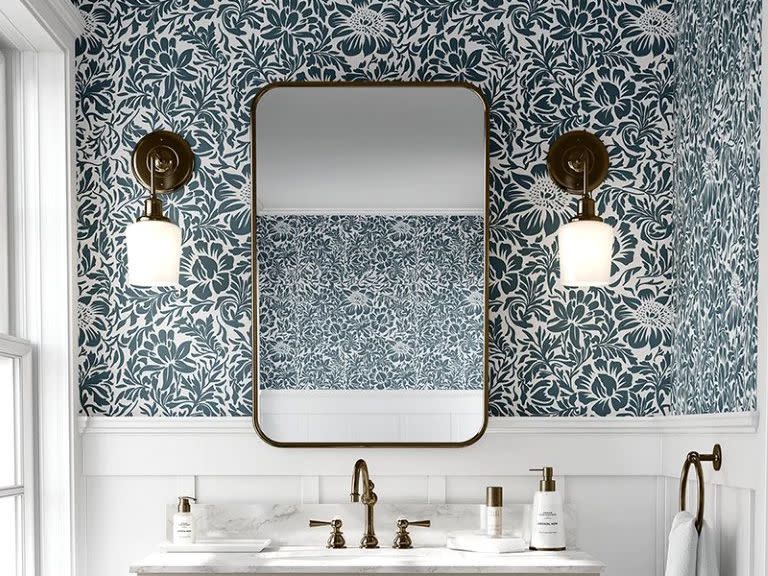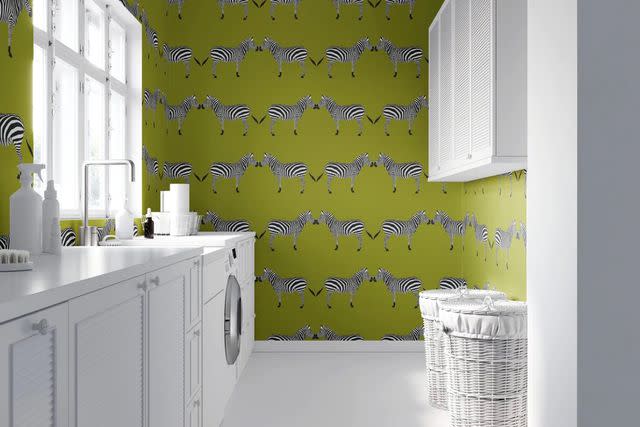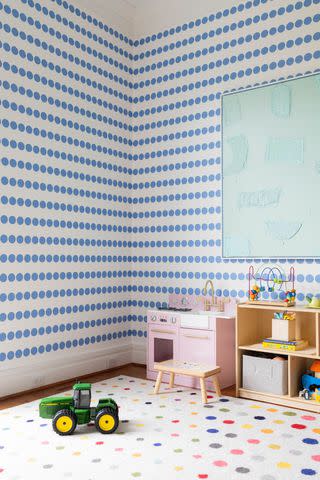Shop Like A Pro: The Ultimate Guide To Choosing Peel And Stick Wallpaper For Your Space
Discover how to shop for peel and stick wallpaper like a pro with this comprehensive guide.

Liza Pruitt
Wallpaper has been making a major resurgence in recent years, and the excellent news is that renters or those looking for a more temporary fix can easily adorn their walls with beautiful patterns, too, all thanks to peel-and-stick offerings. If you’ve never worked with peel-and-stick wallpaper before, we’re here to walk you through the selection process with some tips from Richmond, Virginia-based Liza Pruitt, who owns an eponymous art gallery and recently launched a wallpaper line. Her papers are available in both traditional and peel-and-stick forms, so there’s truly an option for everyone.
Meet the Expert
Liza Pruitt owns an eponymous art gallery in Richmond, Virginia, and recently launched a wallpaper line on Lizapruitt.com.
Below, Pruitt walks us through the process of shopping for and installing peel-and-stick wallpaper like a pro.
Selecting a Room To Use Peel-and-Stick Wallpaper
As Pruitt explains, peel-and-stick wallpaper can shine in so many different spaces, ranging from dorm rooms and rental apartments to kids’ rooms and nurseries. “It can be easily replaced as children grow and their tastes change from a nursery environment to even teen rooms,” Pruitt says. Many DIY enthusiasts like to work with peel-and-stick wallpaper, she adds, noting that the installation process is much simpler than when working with traditional wallpaper. The back of a bookcase is a great spot in which to add wallpaper, for example.
If you’re hosting an event at your home, peel-and-stick wallpaper can make for a wonderful decor option, Pruitt says, noting that she’s seen it utilized at weddings and charity functions.
When wallpapering a room, it’s entirely your decision whether you’d like to cover all four walls or opt to solely install an accent wall, Pruitt says. She encourages people to not forget about a room’s fifth wall—the ceiling—as wallpaper can certainly shine there, too.
Related: 8 Wallpaper Mistakes That Are All Too Common, According To Interior Designers
Common Misconceptions About Peel-and-Stick Wallpaper
If you’ve hesitated from wallpapering a space in your home in the past due to cost concerns, keep in mind that peel-and-stick wallpaper is much more affordable than traditional alternatives. That said, don’t worry about peel-and-stick wallpaper not being able to stand the test of time as a result—manufacturing techniques have come a long way and result in durable, long-lasting options, Pruitt says.
Additionally, don’t feel as though purchasing peel-and-stick wallpaper means that you’re limited to only using it in certain rooms of the home. As Pruitt explains, “Many peel and stick wallpapers are designed to withstand normal wear and tear, including moisture in bathrooms and kitchens.” Still, she encourages consumers to invest in the highest quality peel-and-stick wallpaper they’re able to source. The PVC-free wallpaper Pruitt sells is made from 100 percent polyester woven fabric with an adhesive backing that allows it to be repositioned anytime within the first 24 hours after installation.
Tips for Installing Peel-and-Stick Wallpaper
On the note of installation, Pruitt advises beginning the process by preparing your wall—clean it using a sponge or cloth and a bit of mild detergent to remove any debris. Ensure the wall dries fully. If you’re going to be using a patterned wallpaper, place all of the panels on the floor and line them up to make sure they’re ready to be hung in the proper order. Pruitt always recommends ordering more wallpaper than you’ll actually need to use so that you’re prepared with extra in the event of any errors.
When cutting wallpaper, Pruitt recommends using a sharp utility knife or scissors. “Take your time to avoid jagged edges or uneven cuts,” she says. To make sure that your wallpaper goes onto the wall smoothly, use a wallpaper smoother or squeegee. “Start from the center and work outward,” Pruitt says. “Smooth out any air bubbles or wrinkles as you go to ensure a seamless finish.”

Liza Pruitt
Using Peel-and-Stick Wallpaper in Small Vs. Large Rooms
Small Rooms
You’ll want to purchase your wallpaper based on the size of the room you’re decorating—small and large spaces call for different colors and patterns, Pruitt says. When working with a small room, it’s best to gravitate toward light colors—think soft pastels or neutral tones, Pruitt says. She explains that these shades “can help smaller rooms feel more spacious and airy by reflecting light and creating a sense of openness. Additionally, Pruitt recommends sticking to a smaller scale pattern in a small room. “Small-scale prints, delicate motifs, or minimalistic designs can add interest without making the room feel cramped,” she says.
That said, if your heart is set on a larger scale pattern, you can certainly go that route in a small room. “Choose wallpapers with large motifs or designs that have plenty of negative space to prevent the room from feeling overcrowded,” Pruitt says.
If you’re looking to fake a higher ceiling in a small room, opt for a pattern with vertical stripes, which Pruitt says will create the illusion of additional vertical space. “Consider using narrow or spaced-out stripes to avoid a busy look,” she says.

Liza Pruitt
Large Rooms
In larger rooms, don’t be afraid to go bold—in fact, Pruitt encourages this. “Rich colors can add warmth, depth, and visual interest to expansive spaces without overwhelming them,” she explains.
As for patterns, the more dramatic, the better in large rooms; these designs will become the space’s focal point.
You may also wish to solely install an accent wall in a large space to divide up the room a bit. “Choose a striking wallpaper design or pattern that complements the room's overall aesthetic and serves as a focal point,” Pruitt suggests.
Related: How To Apply And Remove Peel-And-Stick Wallpaper In Your Home
For more Southern Living news, make sure to sign up for our newsletter!
Read the original article on Southern Living.

